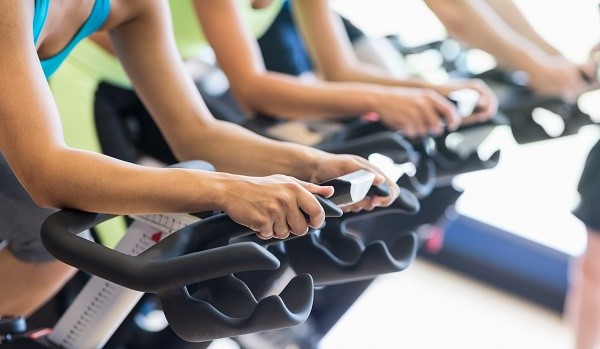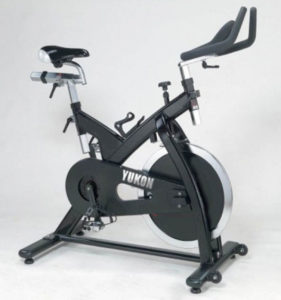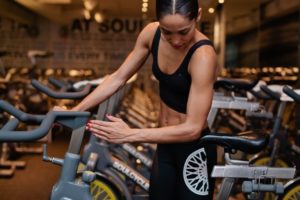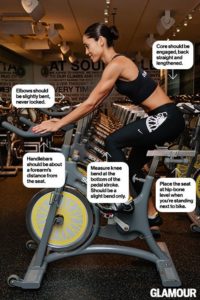Happy in the Saddle

By Coral Lewis, BSc., MPT, CAFCI
Indoor cycling (a.k.a spinning) has become one of the most popular ways in Seattle to fit a quick and sweaty workout into a busy schedule. As a Physical Therapist, I am increasingly seeing client’s whose well-intentioned spin workouts are feeding into their aches and pains and eventually causing injury, usually in their backs and knees.
Look around the spin studio at your next workout – How much movement is happening in your fellow-spinners torsos? Are their hips level? How much side-hinging is happening in their lower back when they pedal? This might sound familiar to you! These are some of the common mistakes that can lead to pain and injury while on the bike. If done correctly, spinning has the potential to be a fantastic addition to a workout regime, but a few key aspects of technique can go a long way in keeping your body injury free.
Watch Your Back!
While sitting on the saddle, allow your torso to hinge forward naturally at the hips while engaging the core to keep the back straight. Relax your neck and shoulders and minimize movement in upper body. Your goal should be to keep your deep core muscles engaged during your riding such that you can minimize the amount of side-to-side deviation of your spine and hips. By working the core muscles during spin class, you can both improve your core strength and prevent back injury. However, be careful not to over clench your core musculature, you still need to utilize your diaphragm to breathe.
Coming Out of the Saddle
Coming out of the saddle is a great way to work on core control and gluteal strength; however, there are a couple common mistakes that happen while pedaling out of the saddle – 1) pedaling too fast, and 2) shifting your body too far forward.
Fast leg/cadence drills while popping out of the seat are hard on your knees so steps need to be taken to mitigate this. When pedaling out of the saddle increase the resistance a few levels to avoid uncontrolled spinning of the legs and increased pressure on the front of your knees, namely your patellofemoral joints.

http://alphasportinggoods.com/cardio/upright-exercise-bikes/yukon
When standing up out of the saddle, you must keep a straight back and hinge at the hips allowing your bottom to hover over the seat while engaging your core and gluteal muscles. Avoid the common mistake of shifting the body forward, tucking the bottom under and putting excess weight onto the arms. Send your buttock back to hover over the saddle – while peddling you should almost feel your bottom brush the seat. To ensure you’re not creeping forward, make sure your knees never go past the resistance knob on the bike. In the picture shown here you can see this knob just above the spin wheel – however the location may vary so this tip is not relevant to ALL bikes).
It’s NOT a Dance Party
As much as I love a good dance party – spin class isn’t the place. Although the music often encourages a little extra “wiggle”, be cautious as to how much bounce and side-to-side sway is taking place. A way to prevent this is to engage the core to keep weight centered over the bike and minimize vertical movement.
Fit Matters
It is important to arrive a few minutes early to class to take the time to set up your bike to fit your body. If you need some extra help, your instructor should be able to help you to do this.
Seat
With your foot on the pedal, your knee should be slightly bent at the bottom of the pedal stroke. Lowering your seat below this will cause increased stress on the front of the knee due to excess knee bend. Additionally, if you have tight hamstrings, be careful not to raise the seat height too much initially as you may put the hamstrings on too great a stretch and end up straining them during your workout. A saddle that is too high can also cause increase rocking side-to-side on the saddle and increase pressure on your perineal tissue, yikes! The seat should also be moved forward or backwards so your knee is over the pedal in the 3 O’clock position. A good jumping off point for this setup can be seen below.

https://www.glamour.com/gallery/5-must-know-tricks-for-positioning-your-spin-bike
Handle Bars
The handlebars may also be adjustable sliding forward/back, up/down- utilize those adjustments to set you reach. Aim for a relaxed and neutral spine with relaxed shoulders and a sight bend in your elbows. If you are newer to cycling, your handle bars should generally be higher so that you aren’t putting your back into a forward flexed position that is too much for it. As your hip/hamstring flexibility improves and core strength increases over time you will likely be able to tolerate a lower position. Making sure that the handles are far enough away from the seat to allow the back to stay straight. Excessive flexed posture can also strain the neck as it forces you to crane your neck to look up at the instructor!
Final Tips!
Ease into it – Remember that your body needs time to accommodate to new stresses and types of exercise. For newcomers to spinning, I would recommend 3 days maximum per week to begin.
Most injuries happen when we are fatigued – It can be easy to lose good form when you get breathless and tired. As we fatigue, it’s common to relax the core, arch the back, or start compensating in other ways. The trick is to find a good balance between working up a sweat and working so hard that you can’t maintain good form.
Listen to your body! Exercise is all about caring for the body! If you begin to feel pain that is not resolved with these technique corrections or if you have any questions about preparing your body for spin class, we would love to see you at Stride Physio where our therapists can help get you happy in the saddle!
Set-Up Summary

https://www.glamour.com/gallery/5-must-know-tricks-for-positioning-your-spin-bike
Note: I would like to acknowledge and thank Scott, our newest member of the Stride Physio team, for contributing his cycling expertise in the writing of this article.



